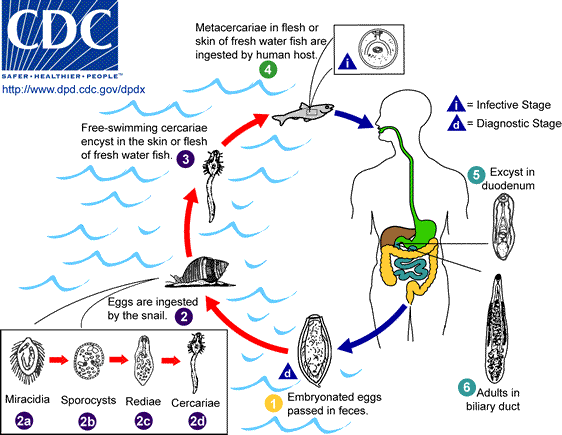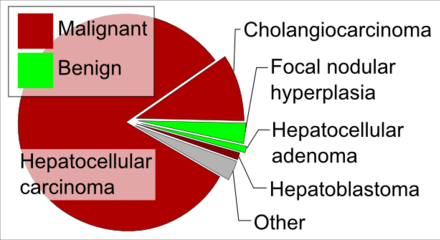Cholangiocarcinoma
Cholangiocarcinoma, also known as bile duct cancer, is a malignancy arising from the bile ducts. It is a rare but aggressive form of cancer with a generally poor prognosis. The disease can manifest in three main types: intrahepatic (within the liver), perihilar (where the bile ducts exit the liver), and distal (common bile duct). The incidence in Western countries is approximately 1–2 cases per 100,000 people annually, with higher rates in Southeast Asia due to liver fluke infections.
Signs and Symptoms

Typical symptoms include abdominal pain, jaundice, weight loss, generalised itching, and fever. The presentation may vary depending on the tumour's location. For example, jaundice is more common in extrahepatic tumours, while intrahepatic tumours often cause pain without jaundice. Blood tests often show elevated bilirubin, alkaline phosphatase, and gamma glutamyl transferase levels, indicating bile duct obstruction rather than liver inflammation.
Risk Factors

Common risk factors include primary sclerosing cholangitis (often associated with ulcerative colitis), chronic liver diseases like hepatitis B and C, cirrhosis, and liver fluke infections. Congenital liver abnormalities, certain parasitic infections, and exposure to specific carcinogens like Thorotrast also increase the risk.
Pathophysiology

Cholangiocarcinoma can arise anywhere along the bile ducts. The cell of origin is likely a pluripotent hepatic stem cell. The disease progresses from hyperplasia and metaplasia to dysplasia and carcinoma, often due to chronic inflammation and bile duct obstruction. Most cholangiocarcinomas are adenocarcinomas, characterised by gland formation or mucin production.
Diagnosis

The diagnosis is confirmed through the examination of tumour cells under a microscope. Blood tests alone are not conclusive, but elevated levels of carcinoembryonic antigen (CEA) and CA19-9 can support the diagnosis. Imaging techniques like ultrasound and CT scans are initial diagnostic tools. Direct imaging of the bile ducts via ERCP or MRCP is often necessary for a definitive diagnosis. Laparoscopy or laparotomy may be used for staging and biopsy.
Treatment
Treatment options depend on the stage and location of the tumour. Surgical resection offers the only potential cure but is often not possible due to the advanced stage at diagnosis. Liver transplantation may be considered in early bile duct cancer cases. Adjuvant chemotherapy and radiation therapy are used post-surgery to improve survival chances. For inoperable cases, palliative chemotherapy and radiotherapy are the mainstays of treatment. Various chemotherapy regimens include agents like 5-fluorouracil, gemcitabine, and cisplatin. Newer treatments like tyrosine kinase inhibitors (infigratinib, pemigatinib) and immune checkpoint inhibitors (durvalumab) are emerging options.

Prognosis
The prognosis for cholangiocarcinoma is generally poor, with a mean survival duration of less than six months for metastatic disease. Surgical resection offers the best chance of survival, with five-year survival rates varying based on tumour location and completeness of resection. Distal cholangiocarcinomas treated with a Whipple procedure have a five-year survival rate of 15 to 25%, while intrahepatic tumours treated with partial hepatectomy have survival estimates ranging from 22 to 66%.

Epidemiology
Cholangiocarcinoma is more prevalent in Asia due to parasitic infections like liver flukes. The incidence increases with age and is slightly higher in men. Studies indicate a rising incidence of intrahepatic cholangiocarcinoma globally, possibly due to better diagnostic methods and increasing prevalence of risk factors like HIV.

Self-assessment MCQs (single best answer)
What is cholangiocarcinoma?
Which of the following is NOT a typical symptom of cholangiocarcinoma?
What is a common risk factor for cholangiocarcinoma in Southeast Asia?
Which type of cholangiocarcinoma occurs within the liver?
What is the primary diagnostic method for confirming cholangiocarcinoma?
Which of the following is a newer treatment option for cholangiocarcinoma?
What is the mean survival duration for metastatic cholangiocarcinoma?
Which imaging technique is often necessary for a definitive diagnosis of cholangiocarcinoma?
What kind of cancer are most cholangiocarcinomas?
Which of the following statements is true regarding the prognosis of cholangiocarcinoma?
Dentaljuce
Dentaljuce provides Enhanced Continuing Professional Development (CPD) with GDC-approved Certificates for dental professionals worldwide.
Founded in 2009 by the award-winning Masters team from the School of Dentistry at the University of Birmingham, Dentaljuce has established itself as the leading platform for online CPD.
With over 100 high-quality online courses available for a single annual membership fee, Dentaljuce offers comprehensive e-learning designed for busy dental professionals.
The courses cover a complete range of topics, from clinical skills to patient communication, and are suitable for dentists, nurses, hygienists, therapists, students, and practice managers.
Dentaljuce features Dr. Aiden, a dentally trained AI-powered personal tutor available 24/7 to assist with queries and provide guidance through complex topics, enhancing the learning experience.
Check out our range of courses, or sign up now!


